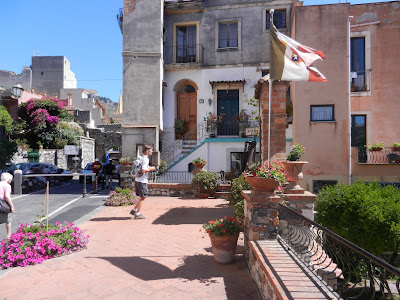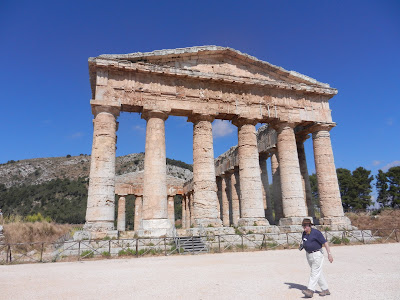The day is much like the others we’ve enjoyed: arrival in port about breakfast time, a tour in the morning, lunch back on the boat because it’s quickest, another tour in the afternoon, a brief siesta, departure from port, a lecture or two by one of the outstanding scholars traveling with us, cocktails (today with the Yale group, including singing) dinner, and a film available in our cabins relating to the events of the day.

To be more specific, because today is so very special, we sail into Naples harbor during breakfast. The gangway has obviously been repaired from the incident in Malta and we depart from the port side again. We board buses with our guide Carmine (and yes, he wears bright red pants!) and head for Pompeii. Unlike some of the other archeological sites we’ve visited, Pompeii is a major tourist attraction and draws many (millions? I don’t recall what we were told) of visitors each year. Our group stays together successfully, but we are given a place and time to meet in case we become separated.
Pompeii is also very different from the other sites we’ve visited because it was buried literally overnight. Instead of being abandoned, as Nestor’s Palace, or overlaid with subsequent cities, as Troy, Pompeii simply disappeared under many feet of ash that quickly solidified into stone. Its art and artifacts were (nearly) perfectly preserved, as were the shapes of the people engulfed in the ash/stone.
 |
| An Ancient Winebar - Pompeii had 82 of these sidewalk refreshment centers! |
Our first stop is a bypass of the tourist areas and a special greeting by Dr. Stephen Ellis of the Pompeii Archaeological Research Project and insight into what his group will begin tomorrow. Would you believe it sounds incredibly familiar? In about 150 bc, in the area of a blue collar neighborhood where they’ll be excavating, families made fish sauce at home: some for home use and the remainder for local sale. Apparently, Spain (or what is now known by that name) began making fish sauce by some vastly cheaper method and underpriced the local Pompeiian fish sauce makers. So they changed. They bought their fish sauce from Spain and the area became one of service providers: diners, wine sellers and winebars, and other forms of service businesses rather than manufacturing. By 75 bc, fish sauce production had ended in the neighborhood and they continued to prosper in their new businesses. I think we now call it outsourcing. We didn't invent it.
Pompeii was also a city (20,000 people) of wanna-be’s. They weren’t Romans. There is much evidence of “putting on the dog” by various families who decorated their homes to appear larger, donated to their local theater foundations to win elections, and built columns of cement or, in repairs of brick, overlaid with materials to make them appear to be marble.
They also had some warning of the catastrophe that was to come. In 62 ce, there was a significant earthquake that caused great damage to the area, but repairs had apparently been completed, or at least were well underway, when the volcanic eruption that killed and covered the city in August of 79. The Roman red bricks (of renovation after the 62 quake) are visible everywhere, augmenting the earlier gray stone of the original construction.
There are two theaters, one for plays and musicals(?) and another, much smaller, for musical performances. We spend some time in the smaller one. There is a small (4”) black stone embedded in the performance area and we each stand at that spot and say something. We hear our voices as we speak! Not as echoes, but our own voices exactly as we speak them. My brief message: “May it please the court.”
Near the theaters is some scratched wall art and in one of the houses, mosaics cover the floors and walls. I am perturbed that these aren't better protected until I learn that all the good stuff has been taken to the archaeological museum in Naples. What remains at Pompeii is among the least and left behind so we might get a sense of the original conditions.
 |
| Excavation to begin tomorrow - Mt. Vesuvius in the background |
We find it fascinating that there was an established width for chariot axles. There were sidewalks everywhere and occasional walkways of stone, spaced so that Pompeiian chariots could pass but other chariots, of differing wheel widths, could not. We clearly see the ruts of chariot wheels in the stone.
After the usual delightful lunch, including today both a pasta bar and pizza, we take a short bus trip to the Naples Archaeological Museum. Pompeii stands as buildings, but its art, including its frescoes, has been relocated to the museum. The mosaics are exquisite! One room-width piece of mosaic art contains 1.5 millions pieces of stone! It is not completely intact, but shows a battle story in incredible detail. Other mosaics contain larger pieces and fewer colors, but the quality of the art is wonderful.

We also are fascinated by cement reconstructions of people and a dog. Pompeii was never covered by lava, only by ash. Its people died of poison gas, then were covered by a layer of ash between 9 and 21 feet thick. The cloud from the volcanic eruption created heavy rain of both water and more ash that turned to stone at some point. Fairly recent archeologists realized that there were cavities in the stone created by bodies. The bodies had completely decayed, but left behind holes in the now-stone in the shapes of their bodies. They found that if they filled a hole that they discovered with cement, it might turn into the shape of a body. We see the cement shape of a very pregnant woman, a dog in agony with a chain about its neck who could not escape the fumes, and a tree stump. Oh well, can’t win them all.




























